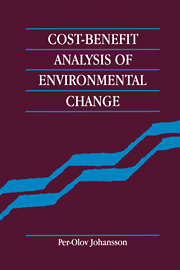Book contents
- Frontmatter
- Contents
- List of figures
- Preface
- 1 Introduction
- 2 Some basic concepts
- 3 Consumer surplus measures
- 4 Valuing public goods: practical methodologies
- 5 General equilibrium cost-benefit rules
- 6 Cost-benefit rules, national income accounts and sustainable development
- 7 Valuation and aggregation: intragenerational and intergenerational issues
- 8 Cost-benefit rules in a risky world
- 9 Valuing changes in access conditions, health risks and information
- 10 Empirical applications
- 11 Policy instruments and international environmental problems
- Notes
- References
- Index
9 - Valuing changes in access conditions, health risks and information
Published online by Cambridge University Press: 15 January 2010
- Frontmatter
- Contents
- List of figures
- Preface
- 1 Introduction
- 2 Some basic concepts
- 3 Consumer surplus measures
- 4 Valuing public goods: practical methodologies
- 5 General equilibrium cost-benefit rules
- 6 Cost-benefit rules, national income accounts and sustainable development
- 7 Valuation and aggregation: intragenerational and intergenerational issues
- 8 Cost-benefit rules in a risky world
- 9 Valuing changes in access conditions, health risks and information
- 10 Empirical applications
- 11 Policy instruments and international environmental problems
- Notes
- References
- Index
Summary
Thus far, the value of an environmental asset has been considered in the context of a stochastic availability or quality. Frequently, however, one would expect a policy to affect the probability of a particular event without necessarily ensuring a certain outcome. For example, there is no guarantee that a programme aiming at the preservation of an endangered species will be successful. Rather, it is expected to increase the probability of survival of the species in question. Similarly, pollution of the air and the water changes the probability that people are stricken with illness.
This chapter concentrates on a discussion of money measures that can be used to assess the value of changes in probability distributions (access conditions). Section 9.1 defines the concept of access value and money measures that can be used to capture access value in applied studies. Sections 9.2 and 9.3 are devoted to money measures of changes in human health, and ultimately the value of life, while section 9.4 presents an empirical study valuing health effects due to air pollution. The chapter then turns to a discussion of the value of information, when some consequences of a project may be irreversible. As noted by Pindyck (1991, p. 1110), the ability to delay an irreversible investment expenditure invalidates the net present value rule as it is usually taught to students in business school: invest in a project when the present value of its expected cash flows is at least as large as its cost. The concept of quasi-option value is defined.
- Type
- Chapter
- Information
- Cost-Benefit Analysis of Environmental Change , pp. 156 - 177Publisher: Cambridge University PressPrint publication year: 1993



